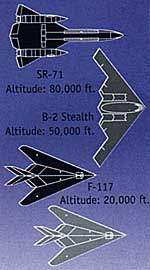|
observer, his angle of view, the position of the sun, and the
presence of haze or clouds. Altitude is extremely important.
A jetliner at its cruising height always appears brightly lit
in the sky, because dust and moisture in the air beneath
the aircraft scatter light onto
its underside. There are
relatively few particles of
dust and water in the thin
air above the airplane.
So the higher the plane
flies, the more light is
scattered onto it,
and the darker the
sky behind it. The
dark color that
absorbs as much
light as possible
provides the best
camouflage for
a high-flying
airplane.

So the higher the plane flies, the more light is scattered onto
it, and the darker the sky behind it.
The dark color that absorbs as much light as possible provides
the best camouflage for a high-flying airplane. But even the
jet-black Blackbird and U-2 spyplanes look brighter than the
skv when seen from below as they cruise at 80,000 feet. At lower
altitudes, there is less light-scattering atmosphere below the
aircraft, so lighter colors provide the least contrast.
For Have Blue, Lockheed devised a scheme of graduated grays,
lighter on the bottom and darker on top. The aircraft's designers
also planned to test light apertures, which would be installed
on the sides and undersurfaces of the airplane, about two feet
apart. (Seen from a distance, the individual lights would blur
into a single image.) The apertures would be connected to a
central light source by fiber-optic lines, and controlled by
sensors on the upper side of the aircraft. The sensors would
"read" the background light and adjust the skin's luminance
to mirror it. This system never flew on Have Blue, possibly
because the
|
first aircraft was lost in an accident. Work on visual stealth
continued, however. In 1980, the Air Force tested a small aircraft,
probably unmanned, under a project

known as IMCRS (what the acronym stands for is not known). The
aircraft's lower wing skins incorporated slit-like Fresnel lenses
to beam light ahead of and below the aircraft, in the direction
of the most likely threats.
The IMCRS experiment may have been related to a Defense Advanced
Research Project Agency program known as Active Camouflage.
Under that program, a small, powered drone was fitted with fluorescent
lamps and tested at the White Sands Missile Range with so much
success that the project has since been reclassified as Top
Secret.
Neither of these lighting systems were adopted for stealth
aircraft in the 1980s. They were complex to install, and their
effects were difficult to predict and test. Carefully designed
conventional camouflage worked well enough under most circumstances
to ensure that an aircraft would not be visible before a radar
could detect it.
So why were the first F-117s painted soot black instead of
a toned gray scheme that would provide better camouflage? One
Lockheed engineer recalls that the commander of Tactical Air
Command "didn't believe that real fighter pilots flew pastel-colored
airplanes." One Air
|
Force source close to the program says that some senior officers
doubted the F-117 could survive in daylight, and wanted to ensure
that nobody would try it.
Color
Counts
Light colors would be optimal for the un- derside of the future
Joint Strike Fighter. which will fly relatively low for ground
at- tacks. Some experts say the best color for a fighter Is
pink, but pilots may object.


The
higher an aircraft flies, the darker it should be to hide
from enemies. The F-117 was originally painted a dark black,
but has recently been seen in gray. |
Black is one of the least stealthy colors for daytime flying
at medium altitudes. In fact,the British Roval Air Force is
painting its trainers black to make them more visible and reduce
the risk of collisions. Black isn't much good at night either,
because there is nearly always some light from the moon. That's
why the latest F-117s have been seen in a more sensible gray
color.
The B-2 stealth bomber's underside is a very dark gray. Many
people think that it is designed to attack only at night, like
thc F-117. This is unlikely, because thc B-2 was designed to
bomb Russia, and the most direct route from the United States
lies smack across the Arctic Circle, where thc sun shines 21
hours a day for a large part of the year.
The B-2's underside is dark because it cruises at altitudes
as high as 50,000 feet, where a dark gray blends into the sky.
It does not use an "active camouflage" lighting system, but
it may have an upward-facing light sensor that tells the pilot
when to increase or reduce altitude to match the changing luminance
of the sky. It appears likely that active camouflage will make
a comeback in the 2000s.
|

